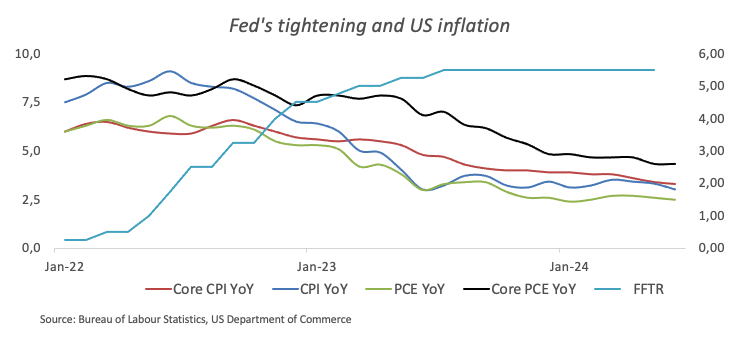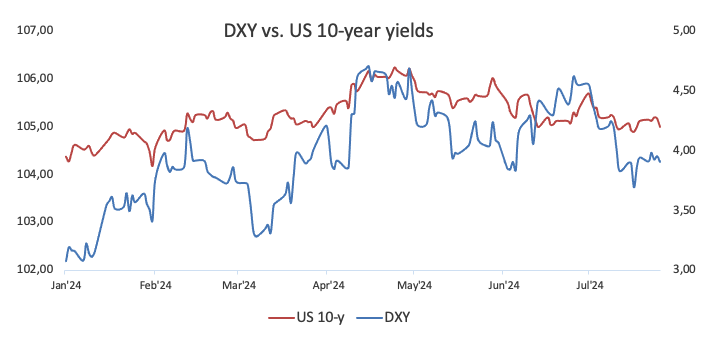- US Dollar Index (DXY) closes the week with modest losses.
- US inflation tracked by the PCE remained sticky in June.
- The Fed is widely anticipated to keep its rates unchanged.
Decent contention emerged around 103.60
The Greenback navigated an erratic range so far this week, leaving the USD Index (DXY) floating in the 104.00–104.50 band against the backdrop of alternating risk appetite trends but, particularly, closely following developments around the Japanese Yen, which has become the best performer among its G10 peers so far in the month.
Despite the index managing to bounce off four-month lows near 103.60, it still needs to surpass the critical 200-day SMA at 104.34 in a sustainable fashion to restore the constructive outlook and dissipate fears of a deeper retracement.
The policy gap between the Fed and other banks is set to dwindle
The US Dollar’s (USD) bumpy road in the past five days followed almost exclusively events around the Japanese Yen, which, concurrently, came in response to a large unwind of short positions, expectations of a potential rate hike by the Bank of Japan (BoJ) at its meeting on July 31, as well as effects from the latest FX intervention by the BoJ/MoF tandem.
Also bolstering the side-lined tone in the Greenback came rising expectations that the Fed might start cutting its Fed Funds Target Range (FFTR) at its September gathering. Any move on rates at the Fed’s July 31 meeting appears absolutely discarded.
It is worth noting, however, that speculation of a September interest rate cut has suddenly and strongly commenced to pick up pace the minute after US inflation figures gauged by the Consumer Price Index (CPI) showed that the disinflationary trend in the US economy had resumed its traction in June. Those expectations were later reinforced by the extra cooling of the domestic labour market.
In addition, US inflation tracked by the Personal Consumption Expenditure (PCE) also showed a decline over the last twelve months in the headline print (2.5% vs. May’s 2.6%) while remaining sticky when it came to the core reading (2.6% vs. May’s 2.6%).

Meanwhile, the euro area, Japan, and the United Kingdom are all experiencing increasing disinflationary pressures. Against that backdrop, the European Central Bank (ECB) cut rates by 25 bps in June and delivered a dovish hold in July, while subsequent comments from policymakers left the door open to another rate cut beyond the summer. Furthermore, the Swiss National Bank (SNB) unexpectedly cut rates by 25 bps on June 20, while investors continue to pencil in a probable rate cut by the Bank of England (BoE) at its meeting next week. In contrast, the Reserve Bank of Australia (RBA) is expected to begin its easing cycle in the second half of 2025. Contrasting the above, while the Bank of Japan (BoJ) delivered a dovish message on June 14, another rate hike on July 31 has now emerged on the horizon.
Two interest rate cuts in 2024 now appear to be the most feasible scenario
The increasing market speculation about an earlier start to the Fed's easing cycle has been propped up by positive data. Given the decline in domestic inflation, along with a recent slowdown in key areas like the labour market and the manufacturing sector, market participants are now fully anticipating a quarter-point rate reduction in September.
The Fed is widely forecast to keep its rate intact next week, although market participants are expected to closely follow any changes in the Committee’s message, as its latest projection pointed to just one interest rate reduction, likely in December.
According to the FedWatch Tool by CME Group, there is about a 99% chance of rate cuts at the September 18 meeting and around a 98% chance of lower rates by year-end.
Something to consider with your morning coffee: The growing possibility of another Trump administration and the likely return of tariffs could disrupt (or even reverse) the ongoing disinflationary trend in the US economy, possibly shortening the Federal Reserve's easing cycle.
US yields remained choppy
The performance of the US fixed-income universe showed mixed results across the yield curve, as the short end finished the week with marked losses and revisiting levels last seen in January, while the belly retreated marginally and the long end clinched its second consecutive gain.

Upcoming key events
The salient event next week will be the Federal Open Market Committee (FOMC) event. Once passed, investors should shift their attention to the labour market, with the publication of the ADP report, the usual weekly Initial Jobless Claims and the Nonfarm Payrolls. In addition, the Consumer Confidence gauged by the Conference Board will also be in the spotlight along with the ISM Manufacturing PMI.
Techs on the US Dollar Index
The DXY lingers over the 200-day SMA of 104.34.
If bears regain the upper hand, the US Dollar Index could return to the July low of 103.65 (July 17) ahead of the March low of 102.35 (March 8). Further south, the December low of 100.61 (December 28) precedes the psychological threshold of 100.00.
On the upside, DXY faces interim hurdles at the 100-day and 55-day SMA at 104.84 and 104.86, respectively, before the June top of 106.13 (June 26), which is slightly below the 2024 peak of 106.51 (April 16). Once the index clears this zone, it may embark on a test of the November high of 107.11 (November 1), followed by the 2023 top of 107.34 (October 3).
Economic Indicator
Fed Interest Rate Decision
The Federal Reserve (Fed) deliberates on monetary policy and makes a decision on interest rates at eight pre-scheduled meetings per year. It has two mandates: to keep inflation at 2%, and to maintain full employment. Its main tool for achieving this is by setting interest rates – both at which it lends to banks and banks lend to each other. If it decides to hike rates, the US Dollar (USD) tends to strengthen as it attracts more foreign capital inflows. If it cuts rates, it tends to weaken the USD as capital drains out to countries offering higher returns. If rates are left unchanged, attention turns to the tone of the Federal Open Market Committee (FOMC) statement, and whether it is hawkish (expectant of higher future interest rates), or dovish (expectant of lower future rates).
Read more.Next release: Wed Jul 31, 2024 18:00
Frequency: Irregular
Consensus: 5.5%
Previous: 5.5%
Source: Federal Reserve
US Dollar PRICE Today
The table below shows the percentage change of US Dollar (USD) against listed major currencies today. US Dollar was the strongest against the Swiss Franc.
| USD | EUR | GBP | JPY | CAD | AUD | NZD | CHF | |
|---|---|---|---|---|---|---|---|---|
| USD | -0.17% | -0.16% | -0.11% | 0.05% | -0.34% | -0.18% | 0.10% | |
| EUR | 0.17% | 0.00% | 0.07% | 0.25% | -0.18% | 0.01% | 0.28% | |
| GBP | 0.16% | -0.00% | 0.04% | 0.23% | -0.18% | -0.00% | 0.27% | |
| JPY | 0.11% | -0.07% | -0.04% | 0.15% | -0.22% | -0.07% | 0.23% | |
| CAD | -0.05% | -0.25% | -0.23% | -0.15% | -0.40% | -0.25% | 0.05% | |
| AUD | 0.34% | 0.18% | 0.18% | 0.22% | 0.40% | 0.18% | 0.49% | |
| NZD | 0.18% | -0.01% | 0.00% | 0.07% | 0.25% | -0.18% | 0.28% | |
| CHF | -0.10% | -0.28% | -0.27% | -0.23% | -0.05% | -0.49% | -0.28% |
The heat map shows percentage changes of major currencies against each other. The base currency is picked from the left column, while the quote currency is picked from the top row. For example, if you pick the US Dollar from the left column and move along the horizontal line to the Japanese Yen, the percentage change displayed in the box will represent USD (base)/JPY (quote).
Information on these pages contains forward-looking statements that involve risks and uncertainties. Markets and instruments profiled on this page are for informational purposes only and should not in any way come across as a recommendation to buy or sell in these assets. You should do your own thorough research before making any investment decisions. FXStreet does not in any way guarantee that this information is free from mistakes, errors, or material misstatements. It also does not guarantee that this information is of a timely nature. Investing in Open Markets involves a great deal of risk, including the loss of all or a portion of your investment, as well as emotional distress. All risks, losses and costs associated with investing, including total loss of principal, are your responsibility. The views and opinions expressed in this article are those of the authors and do not necessarily reflect the official policy or position of FXStreet nor its advertisers. The author will not be held responsible for information that is found at the end of links posted on this page.
If not otherwise explicitly mentioned in the body of the article, at the time of writing, the author has no position in any stock mentioned in this article and no business relationship with any company mentioned. The author has not received compensation for writing this article, other than from FXStreet.
FXStreet and the author do not provide personalized recommendations. The author makes no representations as to the accuracy, completeness, or suitability of this information. FXStreet and the author will not be liable for any errors, omissions or any losses, injuries or damages arising from this information and its display or use. Errors and omissions excepted.
The author and FXStreet are not registered investment advisors and nothing in this article is intended to be investment advice.
Recommended Content
Editors’ Picks

EUR/USD treads water just above 1.0400 post-US data
Another sign of the good health of the US economy came in response to firm flash US Manufacturing and Services PMIs, which in turn reinforced further the already strong performance of the US Dollar, relegating EUR/USD to the 1.0400 neighbourhood on Friday.

GBP/USD remains depressed near 1.2520 on stronger Dollar
Poor results from the UK docket kept the British pound on the back foot on Thursday, hovering around the low-1.2500s in a context of generalized weakness in the risk-linked galaxy vs. another outstanding day in the Greenback.

Gold keeps the bid bias unchanged near $2,700
Persistent safe haven demand continues to prop up the march north in Gold prices so far on Friday, hitting new two-week tops past the key $2,700 mark per troy ounce despite extra strength in the Greenback and mixed US yields.

Geopolitics back on the radar
Rising tensions between Russia and Ukraine caused renewed unease in the markets this week. Putin signed an amendment to Russian nuclear doctrine, which allows Russia to use nuclear weapons for retaliating against strikes carried out with conventional weapons.

Eurozone PMI sounds the alarm about growth once more
The composite PMI dropped from 50 to 48.1, once more stressing growth concerns for the eurozone. Hard data has actually come in better than expected recently – so ahead of the December meeting, the ECB has to figure out whether this is the PMI crying wolf or whether it should take this signal seriously. We think it’s the latter.

Best Forex Brokers with Low Spreads
VERIFIED Low spreads are crucial for reducing trading costs. Explore top Forex brokers offering competitive spreads and high leverage. Compare options for EUR/USD, GBP/USD, USD/JPY, and Gold.